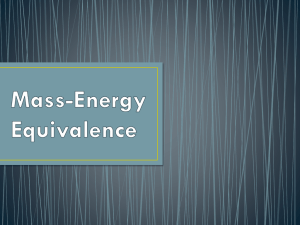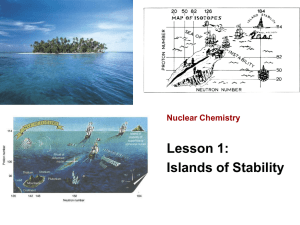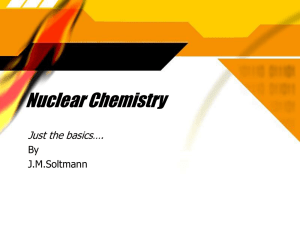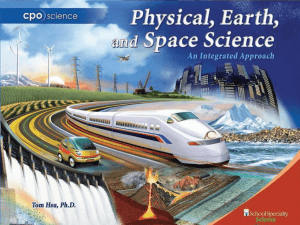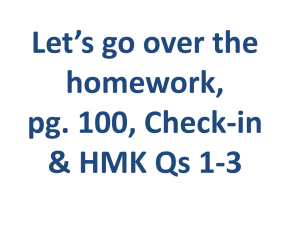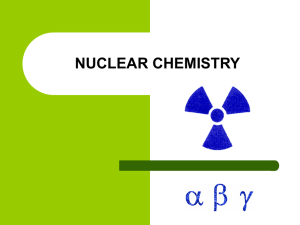Nuclear Reactions Review powerpt
advertisement
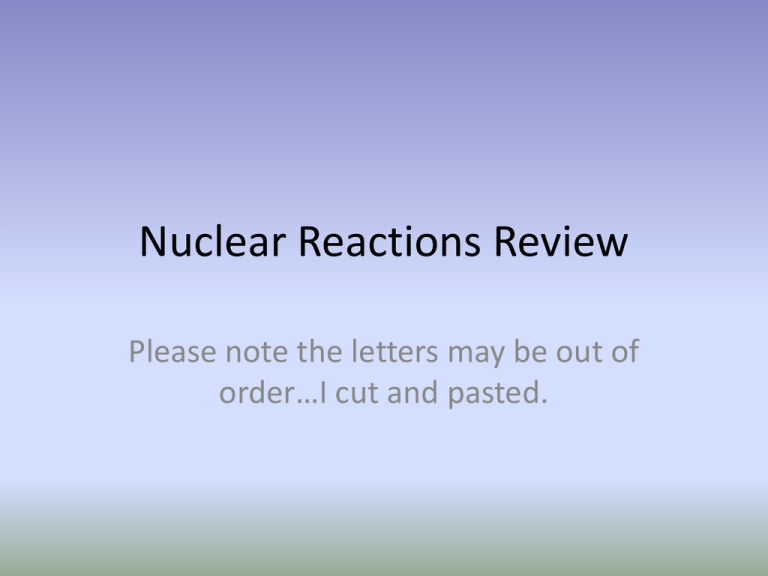
Nuclear Reactions Review Please note the letters may be out of order…I cut and pasted. Alpha particles a.are positively charged. b.consist of two protons and four neutrons. c.can penetrate any thickness of matter. d.All of the above In the equation E = mc2, c stands for a.carbon. c.the speed of light. b.the total energy. d.the size of the particle. Radon gas is produced a.by smoking cigarettes. b.in nuclear power plants. c.through radioactive decay of uranium-238 in Earth’s crust. d.as a result of rotting wood in the basements of houses. What holds protons and neutrons together in a nucleus? a.like charges attracting c.strong nuclear force b.like charges repelling d.atomic mass In a stable nucleus, the attractive forces are _____ the repulsive forces. a.weaker than c.canceled out by b.stronger than d.equal to During fission, some of the parent nuclear mass is converted into a.energy. c.critical mass. b.heavier nuclei. d.protons. A nuclear chain reaction occurs when excess _____ collide with other nuclei. a.protons c.nuclei b.neutrons d.gamma rays Fusion produces _____ nuclei. a.same-sized c.larger b.smaller d.All of the above Which of the following is not a source of natural background radiation? a.the sun c.rocks b.X-ray machines d.soil Which of the following is an advantage of nuclear energy as a power source? a.Nuclear waste is not radioactive. b.Nuclear plants are low in cost. c.Nuclear energy does not produce air pollution. d.Waste can be stored anywhere. Which of the following is a disadvantage of nuclear energy as a power source? a.Nuclear energy produces less energy than the burning of coal. b.Nuclear energy produces air pollution. c.Nuclear waste must be safely stored. d.The fuel source is very limited. The nuclear power used for electricity is produced by a.fusion. c.a chemical reaction. b.fission. d.radon gas. The process of nuclear change in an atom of radioactive material is called a.radioactive decay. c.nuclear mass. b.isotopes. d.radon. When a nucleus undergoes nuclear decay by gamma rays, the atomic number of the new element a.remains the same. c.increases by one. b.decreases by one. d.increases by two. The attractive force between protons and neutrons in a nucleus caused by the strong nuclear force acts only a.outside the nucleus. c.in unstable isotopes. b.over a very short distance. d.intermittently. Nuclei with too many or too few neutrons are a.never found. c.unnatural. b.unstable. d.stable. Fusion occurs when nuclei a.split. c.mutate. b.combine. d.gain energy. Short-lived isotopes that are used in fields such as agriculture and medicine are called a.trace elements. c.radioactive tracers. b.carbon tracers. d.alpha-emitting isotopes. Alpha particles are nuclei of a.oxygen. c.helium. b.nitrogen. d.radium. In radioactive decay, with each successive halflife, half the remaining sample decays to form another a.nucleus. c.life-form. b.element. d.proton. The process of the production of lighter nuclei from heavier nuclei is called a.mass energy. c.magnetism. b.fusion. d.fission. The isotopes of hydrogen that are commonly used in fusion are a.hydrogen and deuterium c.tritium and deuterium b.hydrogen and tritium d.none of the above An instrument that is used to determine the radioactivity in a substance is called a a.nuclear reactor c.emission detector b.Geiger counter d.radioactivity detector Radioactive materials have unstable A.electrons. C.protons. B.nuclei. D.neutrons. 2.The type of nuclear radiation that can penetrate farthest through matter is called A.radons. C.neutron emission. B.gamma rays. D.X-rays. 3.Nuclei with too many or too few neutrons are A.never found. C.unnatural. B.unstable. D.stable. 4.The process by which a nucleus splits into two or more smaller fragments, releasing neutrons and energy is called... A.strong nuclear split C.change reaction B.fusion. D.fission. 5.Fusion occurs when nuclei A.split. C.mutate. B.combine. D.gain energy. 6.A fission chain reaction can be slowed by using materials that will A.absorb some of the neutrons. B.convert some of the neutrons to protons. C.increase the rate of the neutron multiplication. D.decrease the amount of available oxygen in the air. • 7. You prepare a large screened-in box, inside which you place several dozen mouse traps. You set each trap and on each mouse trap you place a ping pong ball. You then drop another ping pong ball into the box, which sets off one of the mouse traps, which sets off other mouse traps, and so on. You have just demonstrated • A.a chain reaction. • C.the theory of relativity. • B.fusion. • D.alpha decay. • • • • • 8. Background radiation can come from A.the sun. C.plants. B.water. D.all of the above • 9. Our body tissues are normally protected from most background radiation by • A.special deflectors in the atmosphere. • B.our outer skin. • C.staying indoors or in protected areas. • D.special molecules within our bodies that fight radiation. • 10. Short-lived isotopes like magnesium-28 that are used in fields such as geology, agriculture, and medicine are called • A.trace elements. • C.carbon tracers. • B.radioactive tracers. • D.alpha-emitting isotopes. • • • • • 11. Radioactive tracers are short-lived A.drugs. C.tumors. B.isotopes. D.rays. • 12. To treat certain brain tumors, doctors can use small beams of ____ that are focused to kill only the tumor cells. • A.X-rays • C.alpha rays • B.beta rays • D.gamma rays • 13. The use of nuclear reactors to generate electricity is • A.decreasing rapidly. • C.found in dozens of countries. • B.found only in the United States. • D.totally safe. • 14. The ideal location for a radioactive-waste storage facility is one that is • A.in a sparsely populated area. • C.far away from ground water • B.in an area free from earthquakes. • D.all of the above • 15. When a fusion reactor for safely generating energy is developed, the element that could meet Earth's energy demands for millions of years is • A.oxygen. • C.hydrogen. • B.nitrogen. • D.lithium. • 16. What two elements are involved in nuclear fusion reactions? • A.barium and krypton • C.uranium and hydrogen • B.uranium and barium • D.hydrogen and helium • 17. Nuclear reactors use __________ to turn large turbines to produce electricity. • A.water • C.wind • B.solar energy • D.steam • 18. Our sun is powered by nuclear __________. • A.fission • C.waste • B.fusion • D.reactors • 19. Which element is the largest source of radiation in the Earth's crust? • A.Uranium • C.Radon • B.Krypton • D.Barium • 20. What is the force that binds protons and neutrons together in the nucleus of an atom called? • A.gravity • C.strong nuclear force • B.magnetic force • D.air force one • 21. What is the name for the process in which light nuclei combine at extremely high temperatures, forming a heavier nucleus and releasing energy? • A.alpha contact • C.fusion • B.fission • D.change reaction • 22. Name one good use of the energy produced in a controlled chain reaction. • A.tanning • C.electricity • B.x-rays • D.nuclear waste • 23. During beta decay, a nucleus • A.gives up two protons and two neutrons. • B.maintains the same number of protons and neutrons. • C.loses a proton and gains a neutron. • D.gains a proton and loses a neutron. • 24. In alpha decay, the mass number of the atom before the decay • A.equals the sum of the mass numbers of the products. • B.does not change after the decay. • C.is the same as the atomic number. • D.cannot be determined. • 25. Which of the following occurs in the nucleus during alpha decay? • A.Two neutrons and two electrons are gained. • B.Two protons and two neutrons are gained. • C.Two neutrons and two electrons are lost. • D.Two protons and two neutrons are lost. • 26. What changes in the nucleus during nuclear decay by gamma rays? • A.energy content • C.atomic number • B.atomic mass • D.All of the above • 27. As a radioisotope tries to stabilize it can transform into a new element. This process will continue until the new element has a stable nucleus and is not radioactive. What is this process called? • Transmutation • Electromagnetic decay • Nuclear radiation • Nuclear mutation

